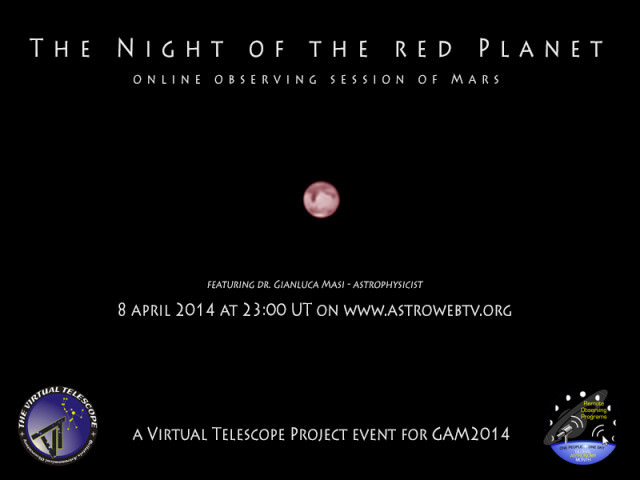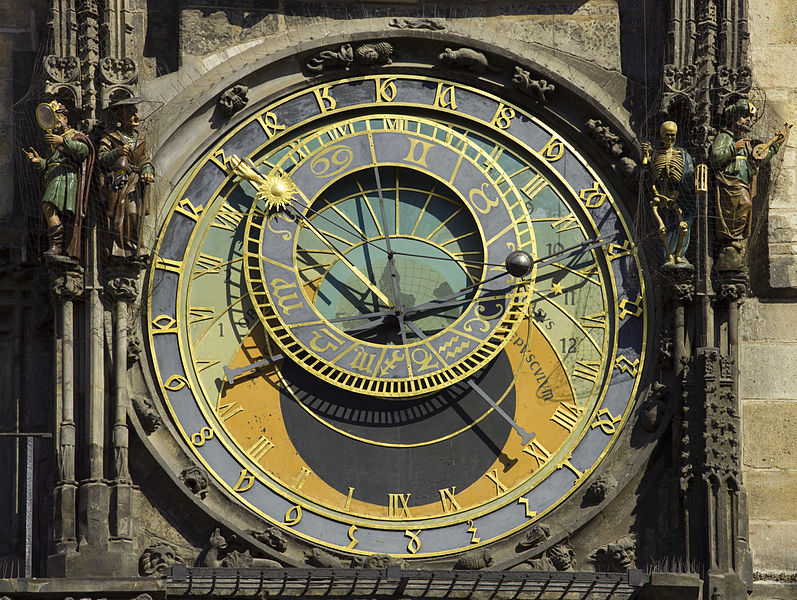Host: Scott Lewis
Guests: Michael Phillips, Bill McLaughlin, Paul Stewart
Continue reading “Virtual Star Party – June 1, 2014: Paul brings his “A” game!”
Virtual Star Party – May 4, 2014: It’s Galaxy Season!
Hosts: Fraser Cain and Scott Lewis
Astronomers: Gary Gonella, Andrew Dumbleton, Stuart Foreman, David Dickinson, Shahrin Ahmad and special guest Henna Khan from Bombay, India
Tonight’s Views:
the Moon’s surface
M44 Beehive Cluster
Neutron Star B224 from HST
All-Sky View
Mars with ice caps and Hellas Basin visible
Comet C/2012 K1 PanSTARRS
Stuart demonstrating how to work with software to process images
M51a Whirlpool Galaxy
M53 Globular Cluster
Rosette Nebula – NGC 2237, 2238, 2239 and 2246
Saturn
Horsehead Nebula (Barnard 33 in emission nebula IC 434) and Flame Nebula (NGC 2024) with a satellite trail
NGC 5139 Omega Centauri
M42 Orion Nebula
M63 Sunflower Galaxy
NGC 7635 Bubble Nebula
Large and Small Magellanic Clouds
We hold the Virtual Star Party every Sunday night as a live Google+ Hangout on Air. We begin the show when it gets dark on the West Coast. If you want to get a notification, make sure you circle the Virtual Star Party on Google+. You can watch on our YouTube channel or here on Universe Today.
Virtual Star Party – April 26, 2014- Hangoutathon Special Edition!
This week’s Virtual Star Party was a special 2-hour Saturday night version recorded as part of the Cosmoquest Hangoutathon. The Star Party at this link starts at 1 hour in – we’ll get an edited version up soon!
Continue reading “Virtual Star Party – April 26, 2014- Hangoutathon Special Edition!”
Webcasts and Forecasts for Tonight’s Total Lunar Eclipse
Are you ready for some eclipse action? We’re now within 24 hours of the Moon reaching its ascending node along the ecliptic at 13:25 Universal Time (UT)/ 9:25 AM EDT on Tuesday morning and meeting the shadow of the Earth just over seven hours earlier.
We’ve written about viewing prospects for tonight’s lunar eclipse. This eclipse is the first total lunar eclipse since December 10th, 2011 and is the first in a series of four — known as an eclipse tetrad — visible from North America in 2014 and 2015. Totality lasts 1 hour and 18 minutes and falls just 29 minutes short of the theoretical maximum, which was last neared on January 21st, 2000 and won’t be topped until July 27th, 2018.
This will be an early morning event for U.S. East Coasters spanning 2:00 to 5:30 AM local (from the start of the partial umbral phases and totality), and a midnight spanning-event for the Pacific coast starting at 11:00 PM Monday night until 2:30 AM Tuesday morning on the 15th.
And as always with celestial events, the chief question on every observer’s mind is: will the skies be clear come show time? Should I stay put, or ponder going mobile?
When it comes to astronomical observing, a majority a mainstream weather resources only tell part of the story, often only listing cloud cover and precipitation percentages. Seeing, transparency, and low versus middle and high cloud decks can often mean the difference between a successful observing session and deciding to pack it in and watch Cosmos reruns online. But the good news is, you don’t need crystal clear skies to observe a total lunar eclipse, just a view of the Moon, which can easily “burn through” a high cirrus cloud deck. We’re going to share a few sites that are essential tools for planning an observing session and what they say about the prospects for seeing tonight’s eclipse.
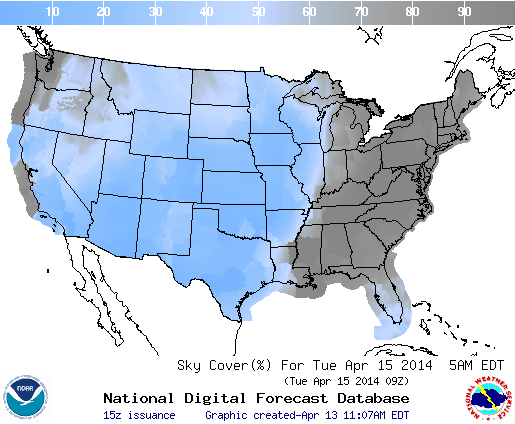
Now the bad news: things aren’t looking good for eastern North America. In fact, the dividing line between “cloudy” and “clear” runs right down through central Ontario and follows the Mississippi River at mid-eclipse, which occurs at 7:47 UT/3:47 AM EDT. There’s a high pressure front sweeping eastward, bringing rain and cloudy skies with it. The Florida peninsula and parts of New England and the Canadian Maritimes may have shots at viewing the eclipse through partly cloudy skies.
The National Oceanic and Atmospheric Administration maintains a great interactive site with graphical interactive forecasts, to include satellite maps. Another long-standing source of good info is the Weather Underground. For tailor-made astronomy forecasts, we’re checking Clear Sky Chart (formerly Clear Sky Clock) and SkippySky daily for upcoming prospects. A great feature in SkippySky is that it not only gives you cloud cover maps, but layers them with high versus middle and low clouds… again, a thin high cloud deck during the lunar eclipse could still mean game on!
Clouded out? There’s a half dozen webcasts planned for tonight’s lunar eclipse as well.
Dependable Slooh will have a live broadcast with commentary on the eclipse starting at 2AM EDT/6:00 UT:
Also, our good friends at the Virtual Telescope Project will be covering the lunar eclipse as part of their ongoing Global Astronomy Month campaign and will utilize several North American observers to cover the event:
NASA is also planning a broadcast out of the Marshall Space Flight Center of the eclipse along with a discussion on Reddit with NASA planetary scientist Renee Weber also starting at 2:00 AM EDT:
The Coca-Cola Space Science Center and Columbus State University also plans host a webcast of the lunar eclipse starting at 3:00 UT/11:00 PM EDT.
Also, the PBS Star Gazers project is planning on hosting a broadcast of the eclipse starting at 1:30 AM EDT/5:30 UT:
And finally, we hope to launch our very own initiation into the world of eclipse webcasting with an hour-long broadcast of the crucial phase transition from partial to total eclipse starting at 2:30 AM EDT/6:30 UT, weather willing:
Live streaming video by Ustream
And hey, word is that doomsday purveyor John Hagee is planning a broadcast of a more “End of the World” bent tonight as well. We didn’t know he was an astronomy fan…
Prospects call for a brighter than normal eclipse, as atmospheric sciences professor at the University of Colorado Richard Keen notes that the Earth’s stratosphere is currently relatively clear of dust and volcanic ash. Still, we’ve been surprised before. The darkness and color of the eclipsed Moon is expressed on what’s known as the Danjon scale. As during eclipses previous, we’ll be data-mining Twitter for estimates and averages to see how they stack up… tweet those observations to #DanjonNumber.
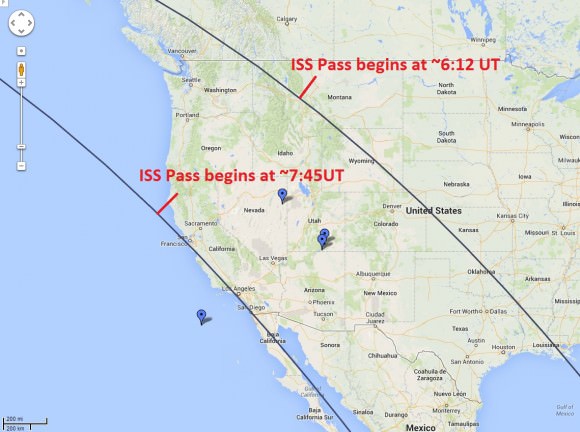
We also ran the possibilities for catching a shadow transit of the International Space Station in front of the eclipsed Moon for North American observers. To our knowledge, this has never been done before. Live near one of the two paths depicted above? You may be the first to accomplish this unusual feat. Check in with CALSky for specifics.
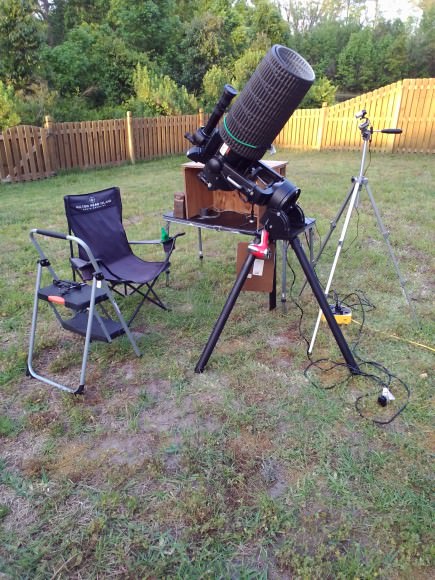
Finally, ever wonder when the next eclipse will occur during the Sunday night Virtual Star Party? If you’re like us, you consider and ponder such astronomical occurrences… and it turns out, the very last lunar eclipse in the current tetrad next year on September 28th, 2015 does just that. And stick around until July 13th, 2037 and we’ll have the first ever total solar eclipse occurring during the show… we just need someone in Australia to stream it!
Tonight’s eclipse is number 56 of saros 122. Reader Rob Sparks notes that the last eclipse (55) in this series occurred on April 4th 1996 and also hosted an extra-special celestial treat, as Comet Hyakutake was just beginning to put on its memorable performance.
In short, don’t fear the “Blood Moon,” but do get out and catch tonight’s fine lunar eclipse… we’ll be doing a post-eclipse photo roundup tomorrow, so be sure to send those pics in to Universe Today!
Virtual Star Party – April 6, 2014: Saturn Rising
Hosts: Fraser Cain and Scott Lewis
Astronomers: David Dickinson, Gary Gonella, Roy Salisbury, Sharin Ahmed, Stuart Forman, Mike Simmons
and some gorgeous pics from Cory Schmitz in the Southern Hemisphere
Scott also shares pics from the viewers
Apps used by Scott: Phases of the Moon and Stellarium
Continue reading “Virtual Star Party – April 6, 2014: Saturn Rising”
Night of the Red Planet: Mars Opposition 2014 Coming Soon!
Mars attacks and comes to a night sky near you this month, and the folks at the Virtual Telescope Project and Slooh are bringing it to you live and in color. Unlike most planets, “Mars viewing season” comes around only once about every two years. And while Mars is shining bright in the sky right now, the “official” event of Mars being closest to Earth happens next week on April 8th, when the Red Planet reaches opposition and shines at magnitude -1.5 in the constellation Virgo.
We’ve written about the prospects and circumstances for viewing Mars this opposition season; now it’s time to watch it live. The webcast starts at 23:00 Universal Time (UT) or / 7:00 PM EDT on the night of Tuesday April 8th, and will feature real-time images brought to you via robotic telescopes worldwide. Hosted by astrophysicist Gianluca Masi and run in conjunction with Astronomers Without Borders, this online observing session of Mars also occurs during Global Astronomy Month. Anyone who tuned in for their recent online Messier Marathon and live broadcasts of several recent Near-Earth Asteroids past our fair planet knows that they’re in for quite a treat!
Want more? Or simply want dual screen live views of “all Mars, all the time?” Our dependable friends over at Slooh will be chronicling the Mars opposition on the same night, starting at a slightly different bat-time at 02:00 UT (the morning of the 9th) which is 10:00 PM EDT the evening of the 8th. Slooh will be presenting a live feed from its automated telescopes based in the Canary Islands off of the coast of West Africa and will feature live commentary from hosts Paul Cox and astronomer and author of The Sun’s Heartbeat Bob Berman.
“Mars has held disproportionate focus for humans since ancient times,” Berman said in a recent press release. “It is neither the closest planet, nor the largest, nor the most detailed through telescopes. Nonetheless, it is the only planet in the universe that shows distinct and sometimes detailed surface features through our telescopes. It is also the most Earthlike body in the known universe, with oxygen bound into its soil and water contained in its ices. Therefore, during the brief two weeks when it comes near us every 26 months, it deserves the limelight.”
Indeed, Mars has captivated observers ever since Christiaan Huygens sketched the first blurry surface feature Syrtis Major back in 1659. Percival Lowell enthralled the public imagination with his sketches of what he thought were canals built by an intelligent and ancient civilization on the Red Planet, and astronomer David Peck Todd once proposed to signal said Martians via balloon aloft in 1909. The SETI Institute’s Seth Shostak noted in his book Confessions of an Alien Hunter that to the average person on the street in the early 20th century, the idea that Mars was inhabited was a given.
Of course, the reality revealed to us by the early Mariner missions in the 1960s onwards paints a bleak picture of a cratered world with a tenuous atmosphere inhospitable to life as we know it.
Still, Mars is a real world, somewhere that rovers are rolling across and exploring even as we peer at it though the eyepiece this month. Six months prior to opposition also the best opportunity to send spacecraft to Mars, and later this year, NASA’s MAVEN and India’s Mars orbiter Mangalyaan both launched in late 2013 will complete the trip.
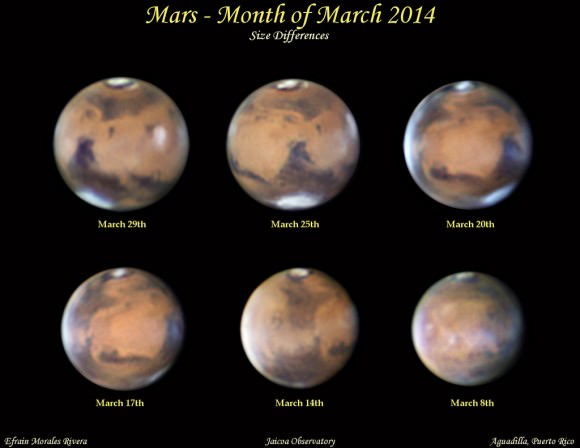
Observing the Red Planet through the eyepiece is easy. The most conspicuous feature is the white northern pole cap, currently tipped towards us. Orographic clouds have also been imaged by amateurs recently over the Hellas basin, and a planet wide dust storm could always crop up at any time. A Martian day is only 37 minutes longer than the Earth’s, meaning you’re only seeing Mars rotated by about 15 degrees of longitude if you observe it at the same time each night. At about 15” across, you could stack 120 Mars diameters as seen this week from Earth across a Full Moon. And no, Mars NEVER appears as big as a Full Moon as seen from the Earth, not this week, every August, or EVER, despite those pesky chain-emails from well meaning co-workers/friends/relatives who just know that you’re into that “space thing…”
All oppositions of Mars are not created equal. In fact, we’re coming off of a series of lackluster oppositions that’ll see Mars getting successively better until 2018, when it’ll nearly top the historic opposition of 2003. For ephemerides buffs, Mars reaches opposition — that is, it’s 180 degrees opposite to the Sun as reckoned in right ascension — on April 8th at 21:00 UT/5:00 PM EDT. It is not quite, however, at its closest to us for 2014: it has still got 0.003 AU (465,000 kilometres, a little over the distance from the Earth to the Moon) and just over 5 days before its closest approach to Earth on the night of April 14th/15th, when a total eclipse of the Moon lies just nine degrees away. The reason opposition and the closest approach of Mars to Earth are not quite in sync is because the orbits of both planets are elliptical, and while Mars is currently moving towards perihelion, Earth is heading toward aphelion on July 4th.
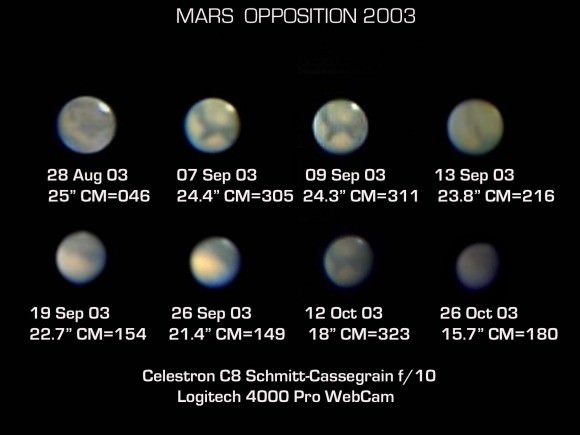
Can’t wait until the 8th? Universe Today hosts a Virtual Star Party every Sunday evening at 11:00 PM EDT / 03:00 UT on Google+ featuring telescopes and commentary by observers and astronomers worldwide. Weather willing, Mars should be a centerpiece object for the show this Sunday night on April 6th.
Be sure to check out Mars at its best this week for 2014, either in a sky near you or online… hey, maybe we’ll be live casting the transit of Earth, the Moon and Phobos someday from Mars on the slopes of Elysium Mons on November 10th, 2084:
Let’s see, hopefully they’ll have perfected that whole Futurama “head in a jar” thing by then…
Enjoy!
Virtual Star Party – March 16, 2014
Host: Fraser Cain & Scott Lewis
Astronomers: David Dickinson, Gary Gonella, Mark Behrendt, Roy Salisbury, Stuart Forman
Continue reading “Virtual Star Party – March 16, 2014”
Virtual Star Party – March 9, 2014: James’ Intimate View of the Moon
Hosts: Fraser Cain & Scott Lewis
Astronomers: James McGee, Gary Gonella, Tom Nathe, Russell Bateman & Peter Lake
Continue reading “Virtual Star Party – March 9, 2014: James’ Intimate View of the Moon”
Daylight Saving Time: A Spring Forward or a Step Back?
The time to change clocks is once again nigh.
We’ll put our unabashed bias as a lover of the night sky right up front: we loathe Daylight Saving Time. And it’s not just because of the biannual hunt through our home for the dozen-odd non-networked clocks that it instigates twice a year. For astronomers, the shift to DST means that true darkness falls much later in the evening, marking the abrupt end of the school star party season not long after March. You don’t have to go far north to about latitude 45 degrees to find areas where it doesn’t get dark until about 11PM local towards mid-summer. And sure, we gain back an extra hour of morning darkness, albeit that too soon dwindles towards summer as well.
In 2014 we (as in a majority of North America) spring forward one hour on March 9th at 2:00 AM local. That’s just one day shy of the earliest that we can now spring forward, as the current convention established by the Energy Policy Act of 2005 during the Bush administration that was enacted in 2007 now sets the beginning of DST as the 2nd Sunday in March.
We’re now on DST for about roughly eight months or 67% of the calendar year. The European Union still shifts forward on the last Sunday of March, meaning that for a span of three weeks every March, the time lag between, say, Eastern Daylight Time and British Standard Time closes briefly to four hours before opening up again to five hours.
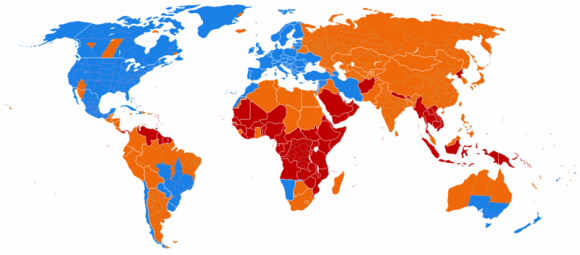
And that’s just for starters.
Of course, there are holdouts even among DST observing countries worldwide. The states of Arizona and Hawaii do not observe DST, nor did a portion of Indiana until 2006. When DST is in effect, you can touch on three time zones in just a few hours’ drive from southeastern Arizona crossing southern New Mexico and into Texas east of El Paso. And you can really mix things up driving across the Navajo nation in northeastern Arizona – which observes DST, unlike the rest of the state – into the Hopi Reservation embedded within it, which rejects DST.
In Canada, most of Saskatchewan ignores DST, as do small portions of British Columbia, Quebec and Nunavut. In 2011, Russia opted to remain on Daylight Saving Time year round, and Australia is sharply divided on the issue of keeping DST. Of course, in the southern hemisphere, astronomical spring and fall are reversed, making UK/US/Australia teleconference scheduling even more confusing this time of year, not to mention the often bewildering state of affairs faced by computer programmers seeking to include every new rule and nuisance concerning local timekeeping worldwide.
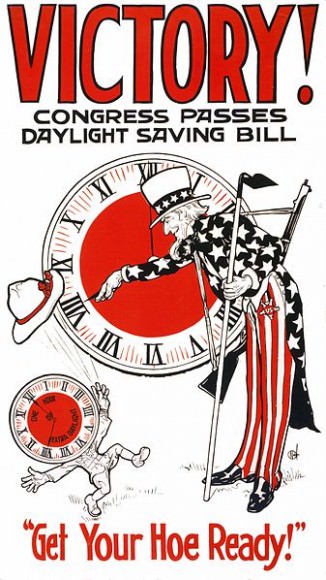
Most folks trace the notion of daylight saving time back to Benjamin Franklin, though DST saw its first implementation by Axis powers in 1916 as a cost saving measure. In the United States, the Standard Time Act of 1918 put DST into effect for the first time, and it was an on again, off again affair through most of the 20th century.
And it’s not just your imagination: we do spring forward earlier and fall back later in the year than we used to. The Uniform Time Act was amended in 1986 to begin DST on the first Sunday in April and run until the last Sunday in October. And as mentioned previously, the Energy Policy Act of 2005 modified this even further under President George W. Bush to our present state of affairs, starting DST on the second Sunday of March through the first Sunday in November.
The primary rational behind DST use is to cut energy consumption. Studies done by the U.S. Department of Transportation during the adoption of DST during the 1970’s OPEC Oil Embargo and the energy crisis showed a small but measurable net savings during the implementation of DST, as well as a small decrease in the crime rate. On the down side, many find it difficult to adjust their body clocks to the shift, with many morning commuters now confronted with darkness.
Is DST a conspiracy of the golf crowd and/or the candy lobby? Anecdotal tales abound that some senators simply wanted few more hours on the course each evening, and “Big Sugar” (a great pro-wrestling name, BTW) was all too willing to oblige. Certainly, we do our trick-or-treating in the daylight now on the last day of October, and will soon be waiting later and later each Sunday evening for astronomical darkness and the start of the Virtual Star Party.
But there are some rumblings of change. This year, Idaho is pushing to scrap DST altogether. And, as is the norm in the often curious state of Florida, lawmakers have proposed to swing even further in the other direction, with a bill dubbed the “Sunshine Protection Act” looking to put the entire state on permanent DST year round in hopes of increasing tourism.
And just last year, a failed White House petition brought up the issue of ending DST. Perhaps their misspelling of DST as “Daylight Savings” (a frequent mistake) detracted from its credibility. What is it that makes us just want to throw that spurious “s” in there?
And that’s the wacky state of time we’re stuck with. Yes, we’ll be ferreting out those non-networked clocks around Astroguyz HQ Sunday morning, bleary from the loss of an hours’ sleep.
Our modest proposal is to do away with DST and time zones entirely, and adopt the use of Universal Time (also referred to as Zulu or Greenwich Mean Time) across the board. I know, it’s a tall order. In the meantime, we’ll be saying #DownWithDST on Twitter, as we await true astronomical darkness at an ever later hour.
And with that, we’ll open the debate up to you, the astute and intelligent readership of Universe Today. Is Daylight Saving Time worth it?
Virtual Star Party – February 23, 2014 – Nebulae, Sunspots, and Planet “X”?!?
Hosts: Fraser Cain & Scott Lewis
Astronomers: David Dickinson, Gary Gonella, James McGee, Mike Simmons, Roy Salisbury, Shahrin Ahmad, Tom Nathe
Tonight’s views:
Jupiter with a nice view of the red spot, Venus approaching zenith, Bubble Nebula, the Pleiades, Orion Nebula, Horsehead Nebula, Flame Nebula, Running Man Nebula, the Moon, the Sun, the ISS (photo), the Rosette Nebula, Orion again, M33, Sunspots, Rosette again, California Nebula (multiple views), M81 & M82, Planet “X” (?!?), Andromeda, Flame Nebula again
We hold the Virtual Star Party every Sunday night as a live Google+ Hangout on Air. We begin the show when it gets dark on the West Coast. If you want to get a notification, make sure you circle the Virtual Star Party on Google+. You can watch on our YouTube channel or here on Universe Today.


